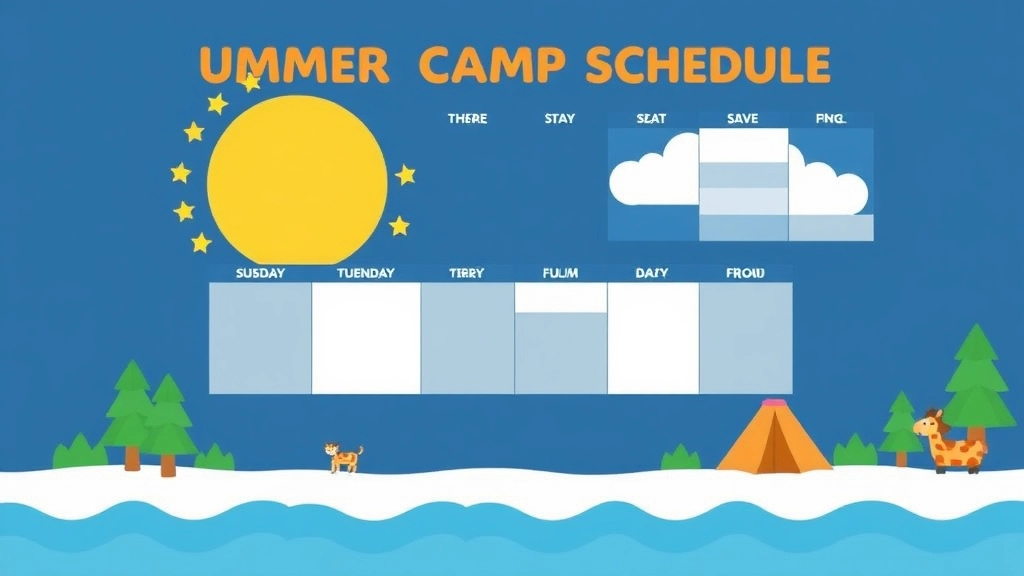Planning a Summer Camp
Planning a summer camp can be a daunting task, but the right Summer Camp Schedule Template can make all the difference. From choosing the perfect template to customizing it for different age groups, this guide covers everything you need to create an engaging and balanced camp schedule. We’ll explore the key elements to include, the pros and cons of daily vs. weekly schedules, and tips for managing time effectively. Plus, we’ll share insights on incorporating rest periods, handling unforeseen changes, and integrating parent communication seamlessly.
Tailoring Your Schedule
Whether you’re running a sports, arts, or adventure camp, this comprehensive guide will help you tailor your schedule to fit your camp’s unique needs. Printable templates can save you time and ensure consistency, while essential tools like Google Sheets and Trello make editing a breeze.
Key Elements to Consider
- Balance Fun and Learning: Ensure activities are engaging and educational.
- Keep Kids Engaged: Plan a variety of activities to maintain interest.
- Smooth Camp Operations: Implement effective management strategies.
With practical tips and real-life examples, you’ll learn how to balance fun and learning, keep kids engaged, and maintain smooth camp operations. So, let’s dive in and make your summer camp the best it can be!
How to Choose the Right Summer Camp Schedule Template
Alright, let’s get straight to it. Choosing the right summer camp schedule template can feel like trying to find a needle in a haystack. You’ve got a million options, and it’s easy to get overwhelmed. But don’t sweat it; we’re going to break it down step-by-step.
What Are Your Main Concerns?
First things first, what are you worried about? Are you thinking:
- How do I fit all the activities in?
- How do I keep it fun but still educational?
- How do I manage different age groups?
These are all valid questions, and guess what? The right template can solve most of these issues.
Key Features to Look For
When you’re picking a template, keep an eye out for:
- Flexibility: Can you easily tweak it for different activities and age groups?
- Clarity: Is it easy to read at a glance? Both for you and the camp staff.
- Structure: Does it have built-in slots for essential elements like meals, breaks, and free time?
Real-Life Example
Imagine you’re running a sports camp. You need a template that allows for multiple activity slots, rest periods, and maybe even some educational sessions. A rigid template won’t cut it. You need something that lets you shuffle things around without losing the plot.
Types of Templates
- Daily Schedules: Great for camps with a consistent daily routine.
- Weekly Schedules: Perfect for camps that offer a variety of activities throughout the week.
Bullet Points to Keep in Mind
- Customizability: Can you add or remove sections easily?
- Visual Appeal: Is it engaging and colourful? Kids (and parents) love that.
- Time Blocks: Are the time slots adjustable? You don’t want to be stuck with 30-minute slots if you need 45.
For more tips and a ready-to-use template, check out our Summer Camp Registration Form Template Guide. And if you’re curious about what activities to include, our Explore Fun Activities at Summer Camp article has got you covered!
Key Elements to Include in a Summer Camp Schedule
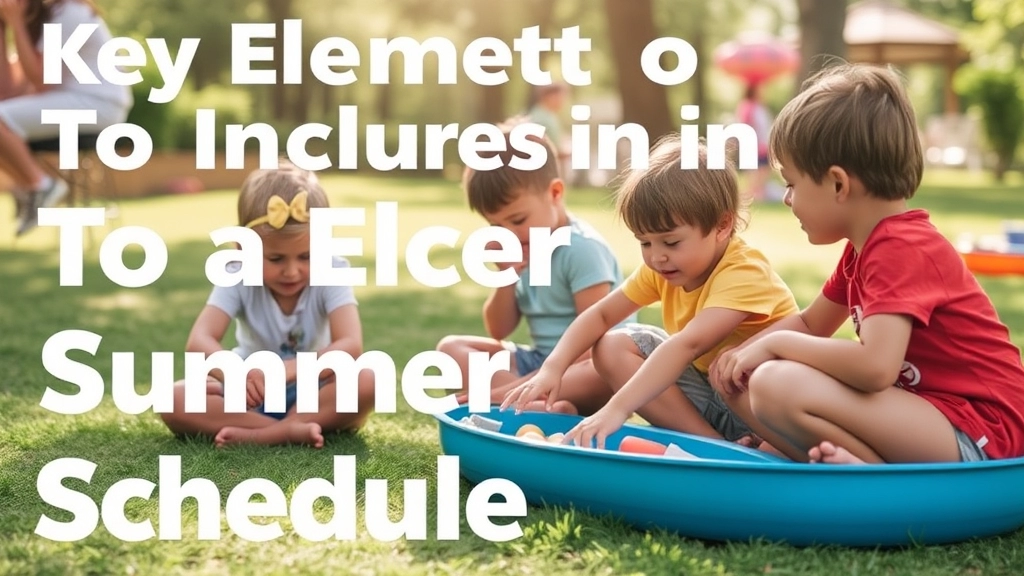
Alright, let’s talk about what really matters when creating a summer camp schedule.
You want to make sure it’s tight, engaging, and covers all bases.
So, what are the key elements you should include?
Activity Variety
You don’t want the kids doing the same thing every day. Mix it up with sports, arts and crafts, nature walks, and team games. Variety keeps everyone excited and engaged.
Structured Time vs. Free Time
Kids need a balance. Too much structure, and they’ll feel like they’re back in school. Too much free time, and chaos ensues. Find that sweet spot.
Meal and Snack Breaks
Hungry kids are cranky kids. Plan for breakfast, lunch, and a couple of snack breaks. And make sure there’s plenty of hydration.
Transition Periods
These are short breaks between activities. They give kids time to wind down and reset. Plus, they help manage the flow of the day.
Special Events
These are the highlights of the camp. Things like talent shows, guest speakers, or field trips. Sprinkle these throughout the schedule to keep the excitement high.
Safety and Emergency Procedures
Yeah, it’s not the fun part, but it’s crucial. Make sure you have time set aside for safety drills and briefings. Everyone needs to know what to do if something goes wrong.
Rest Periods
Kids need downtime to recharge. Schedule some quiet time after lunch or mid-afternoon. It’ll make a huge difference in their energy levels.
Recap
So, to recap, your summer camp schedule should include:
- Activity variety
- Structured time vs. free time
- Meal and snack breaks
- Transition periods
- Special events
- Safety and emergency procedures
- Rest periods
Daily vs. Weekly Camp Schedules: Which to Choose?
Alright, let’s dive into a question that keeps camp organisers up at night: Daily vs. Weekly Camp Schedules: Which to Choose? This is a biggie because the right choice can make or break your camp experience. So, what’s the deal? Should you go for a daily schedule or a weekly one? Let’s break it down.
The Real Questions You’re Asking
- How can I keep kids engaged without overwhelming them?
- What’s the best way to manage staff and resources?
- How do I ensure a balanced mix of activities?
Daily Camp Schedules: The Nitty-Gritty
Daily schedules are all about structure. They offer a detailed breakdown of each day’s activities, making it easy to keep things running like a well-oiled machine. Here’s why you might want to go daily:
- Consistency: Kids know what to expect each day, which can be super comforting.
- Flexibility: You can easily tweak activities based on how things are going. If the kids loved archery on Monday, why not throw in an extra session later in the week?
- Detailed Planning: Every minute is accounted for, so there’s less room for chaos.
But, there’s a flip side:
- Micromanagement: It can feel like you’re constantly juggling a million tasks. Not fun.
- Burnout: Both kids and staff can get tired of the same routine every day.
Weekly Camp Schedules: The Big Picture
Weekly schedules give you a bird’s-eye view of what’s happening over the week. They’re less about the minute-by-minute and more about the overall flow. Here’s why a weekly schedule might be your jam:
- Big-Picture Planning: You can see the whole week at a glance, making it easier to balance activities.
- Reduced Stress: Less daily planning means more time to focus on making each activity awesome.
- Variety: Kids get a mix of activities, which keeps things fresh and exciting. For more ideas, check out our summer camp week themes.
But, here’s the catch:
- Less Flexibility: If something’s not working, it’s harder to change on the fly.
- Overwhelm: A busy week can look daunting to both staff and campers.
So, Which One’s for You?
Here’s the kicker: Why not both? Yep, you heard me right. A hybrid approach can give you the best of both worlds. Start with a weekly overview to map out your big goals and then drill down into daily plans to keep things on track.
Real-Life Example
Last summer, we ran a sports camp and initially went with a weekly schedule. By mid-week, we realised the kids were getting restless with too much free play. We quickly pivoted to a daily schedule for the remaining days, adding structured activities like mini-tournaments and skill drills. The result? Happier campers and more engaged staff. For more on structuring your camp, explore our ultimate guide to summer camp sleepaway fun.
Customising Your Summer Camp Schedule for Different Age Groups
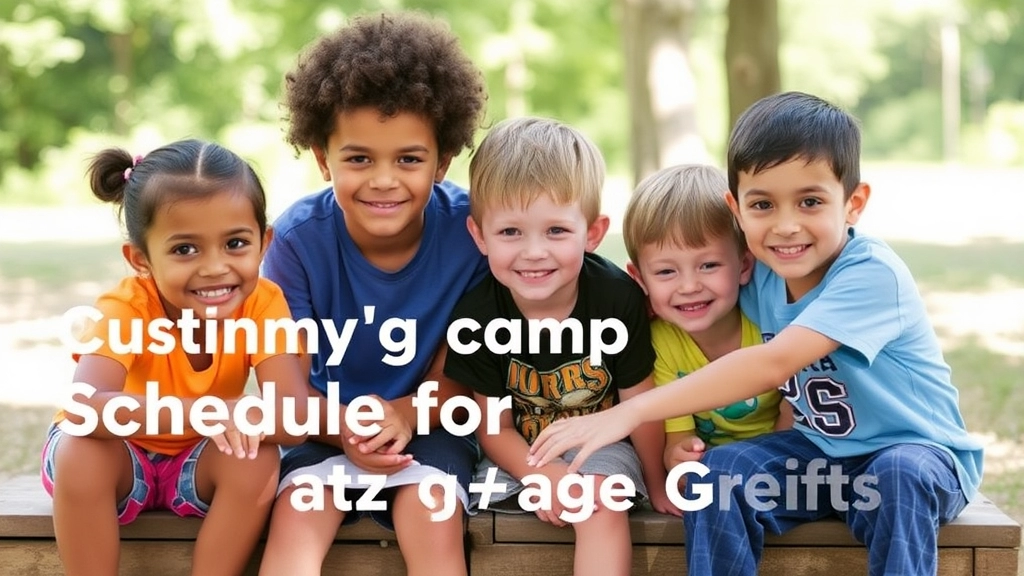
Alright, let’s get real.
One size does not fit all, especially when it comes to summer camp schedules.
Kids are like sponges, but they soak up different things at different ages.
So, how do you customise a summer camp schedule to fit different age groups?
Let’s break it down.
Why Customise?
First off, why even bother customising?
Different age groups have different needs.
- Younger kids need more breaks.
- Teens crave independence and challenges.
- Tweens sit somewhere in between.
Age-Specific Needs
For the Little Ones (Ages 5-7)
These kids are bundles of energy but have short attention spans.
Key Points:
- Frequent breaks: Every 45 minutes.
- Simple activities: Arts and crafts, basic sports.
- Storytime: Keeps them engaged and calm.
For the Tweens (Ages 8-12)
Tweens are curious and ready for more complex activities.
Key Points:
- Structured learning: Science experiments, team sports.
- Independence: Let them choose some activities.
- Social time: Group activities to foster friendships.
For the Teens (Ages 13-17)
Teens want freedom and responsibility.
Key Points:
- Challenging tasks: Leadership roles, advanced sports.
- Flexibility: Allow them to tweak their schedule.
- Skill-building: Workshops, career-oriented activities.
Practical Tips for Customising
Use Age-Specific Blocks
Create time blocks tailored to each age group.
Example:
- Morning: Physical activity for all ages.
- Mid-morning: Learning activities for tweens and teens, free play for younger kids.
- Afternoon: Group activities for all, but different complexity levels.
Mix and Match
Blend different types of activities to keep everyone engaged.
Example:
- Younger kids: 20 minutes of arts, 20 minutes of play.
- Tweens: 30 minutes of science, 30 minutes of sports.
- Teens: 45 minutes of workshops, 45 minutes of free time.
Real-Life Example
Last summer, we had a group of 7-year-olds who loved painting but got restless after 30 minutes.
We split their art sessions with short, fun games.
Result?
Happier kids and better artwork.
Tips for Balancing Fun and Learning in a Camp Schedule
Alright, let’s dive straight into it. Balancing fun and learning in a camp schedule can feel like juggling flaming torches while riding a unicycle. But hey, it’s totally doable. You’re probably wondering, âHow can I keep kids engaged without turning the camp into a classroom?â or âCan fun and education really go hand in hand?â Well, the short answer is: absolutely. Let’s break it down.
Start with Clear Objectives
First things first, know what you want to achieve. Ask yourself:
- What are the key skills or knowledge areas you want the kids to learn?
- How can you make these learning moments enjoyable?
Blend Activities Seamlessly
You don’t want the kids to feel like they’re switching from fun mode to learning mode. Integrate learning into activities naturally. Here’s how:
- Storytelling Sessions: Use engaging stories that teach moral lessons or historical facts.
- Science Experiments: Simple, hands-on experiments that are fun and educational.
- Nature Walks: Turn a hike into a biology lesson by identifying plants and animals.
Use Themes to Your Advantage
Themes can be your best friend. They provide structure and make planning easier. For example:
- Adventure Week: Incorporate treasure hunts with geography lessons.
- Art and Craft Week: Teach about famous artists while kids create their own masterpieces.
Mix Up the Schedule
Variety is the spice of life, and it’s crucial in a camp schedule. Here’s a simple formula:
- Morning: High-energy activities (sports, games)
- Midday: Learning activities (workshops, classes)
- Afternoon: Creative sessions (art, music)
- Evening: Relaxing activities (storytime, movie night)
Incorporate Free Play
Kids need time to be kids. Free play is essential for creativity and social skills. Schedule in:
- Short Breaks: 10-15 minute free play sessions between structured activities.
- Extended Play: An hour or so in the afternoon for kids to choose their own activities.
Balance Group and Individual Activities
Not every kid thrives in group settings. Mix it up with:
- Group Games: Team sports, group challenges
- Solo Time: Reading, journaling, individual crafts
Keep It Dynamic
A static schedule can get boring fast. Keep things fresh by:
- Rotating Activities: Change up the activities each day.
- Surprise Elements: Throw in unexpected fun activities or guest speakers.
Real-World Example
When we ran our summer camp last year, we had a “Science and Nature Week.” Mornings were packed with high-energy games like capture the flag, which we themed around different animal species. Midday, we conducted simple science experiments, like making volcanoes with baking soda and vinegar. Afternoons were for nature walks where kids learned to identify different plants and insects. Evenings were chill with campfires and stargazing. For more inspiration, check out our summer themes for an unforgettable camp.
If you’re looking for camps that offer a perfect blend of fun and learning, consider exploring the top summer camps for teens that focus on both activities and benefits.
Printable Summer Camp Schedule Templates: A Time-Saving Tool
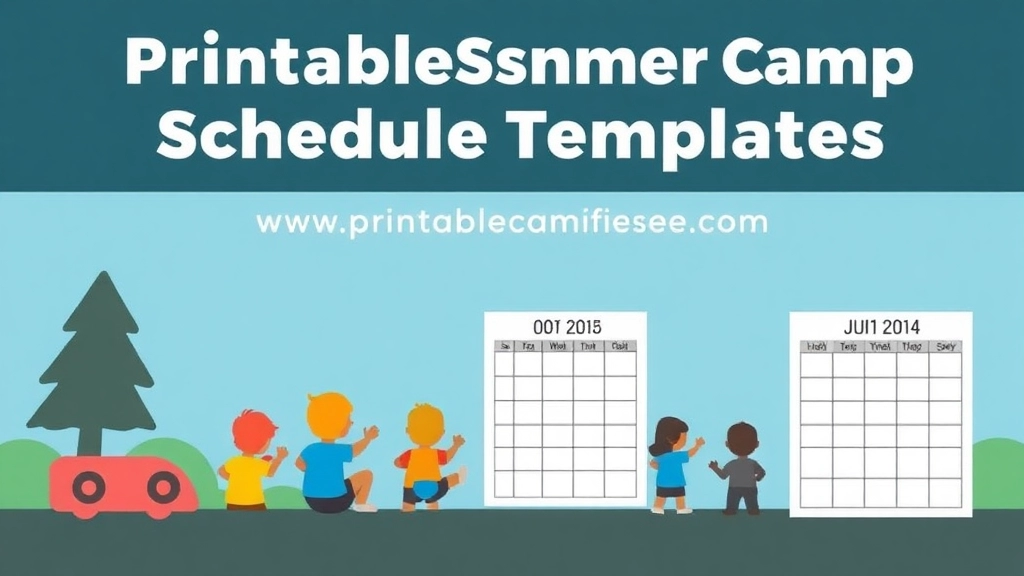
Ever found yourself drowning in the chaos of planning a summer camp schedule?
Trust me, I’ve been there.
You’ve got activities to plan, kids to manage, and parents to keep in the loop.
It’s a lot.
But here’s the game-changer: Printable Summer Camp Schedule Templates.
Why Use Printable Templates?
They save you time.
A ton of it.
Instead of starting from scratch every time, you’ve got a ready-made framework.
Plus, they’re easy to tweak.
Need to swap an activity? No problem.
The Benefits
Let’s break it down:
- Consistency: Keeps your schedule uniform and easy to follow.
- Efficiency: Cuts down planning time massively.
- Professionalism: Looks slick and organised, which impresses parents.
How to Use Them
First, find a template that fits your camp’s vibe.
Sports camp? Look for one that has slots for drills and games.
Arts camp? You’ll need sections for different creative activities.
Download it.
Print it out.
Fill in the blanks.
Real-Life Example
Last summer, I ran an adventure camp.
We had hiking, kayaking, and team-building exercises.
I found a template that had hourly slots and sections for notes.
It was a lifesaver.
Parents loved the clear, detailed schedule.
Kids knew what was coming next.
And I had fewer headaches.
Where to Find Them
Google’s your friend here.
Search for “Printable Summer Camp Schedule Templates”.
You’ll find loads.
Some are free, some might cost a bit.
But trust me, it’s worth it.
Customising Your Template
Got different age groups?
No worries.
Print out separate templates for each group.
You can even colour-code them.
Remember, the goal is to make your life easier.
Final Thoughts
Printable summer camp schedule templates are a no-brainer.
They’re efficient, professional, and adaptable.
And let’s be real, anything that saves us time is a win.
So, grab a template, and make your camp planning a breeze.
Adapting Camp Schedules for Different Camp Types (Sports, Arts, Adventure, etc.)
Ever wondered how to keep a sports camp energetic, an arts camp creative, or an adventure camp thrilling? Adapting your camp schedule to suit different types can be a game-changer. Let’s dive into the nitty-gritty of making your camp schedule fit like a glove for any camp type.
Why Adapt Your Camp Schedule?
First off, why even bother adapting your camp schedule? Well, it’s simple. Different camps have different vibes and goals:
- Sports Camps: Focus on physical activity and teamwork.
- Arts Camps: Prioritise creativity and self-expression.
- Adventure Camps: Emphasise exploration and outdoor skills.
Your schedule needs to reflect these core elements to keep campers engaged and coming back for more.
Sports Camps: Keeping the Energy Up
Sports camps are all about movement and teamwork. Here’s what you need:
- Warm-up Sessions: Start the day with light exercises to get everyone pumped.
- Skill Drills: Break down complex skills into manageable drills.
- Team Games: Incorporate various sports to teach teamwork and strategy.
- Cool Down: End with stretching or light yoga to prevent injuries.
For example, a typical day might look like:
| Time | Activity |
|---|---|
| 9:00 – 9:30 | Warm-up |
| 9:30 – 11:00 | Skill Drills |
| 11:00 – 12:00 | Team Games |
| 12:00 – 1:00 | Lunch Break |
| 1:00 – 2:00 | Strategy Sessions |
| 2:00 – 3:30 | Tournament Play |
| 3:30 – 4:00 | Cool Down |
Arts Camps: Unleashing Creativity
Arts camps need a different approach. Here’s how to keep those creative juices flowing:
- Creative Warm-ups: Start with fun, quick exercises like doodling or improv games.
- Workshops: Offer sessions on different art formsâpainting, sculpture, drama, etc.
- Collaborative Projects: Encourage teamwork through group art projects.
- Showcase Time: Allow campers to display their work at the end of the day.
A sample schedule could be:
| Time | Activity |
|---|---|
| 9:00 – 9:30 | Creative Warm-ups |
| 9:30 – 11:00 | Painting Workshop |
| 11:00 – 12:00 | Drama Session |
| 12:00 – 1:00 | Lunch Break |
| 1:00 – 2:30 | Sculpture Workshop |
| 2:30 – 3:30 | Group Art Project |
| 3:30 – 4:00 | Showcase Time |
Adventure Camps: Embracing the Outdoors
Adventure camps thrive on exploration and survival skills. Here’s your blueprint:
- Morning Hikes: Start the day with a hike to energise and connect with nature.
- Skill Workshops: Teach essential skills like knot-tying, compass reading, or first aid.
- Adventure Challenges: Organise challenges like obstacle courses or scavenger hunts.
- Campfire Sessions: End the day with stories and songs around the campfire.
A typical day might be:
| Time | Activity |
|---|---|
| 9:00 – 10:30 | Morning Hike |
| 10:30 – 12:00 | Skill Workshop |
| 12:00 – 1:00 | Lunch Break |
| 1:00 – 2:30 | Adventure Challenge |
| 2:30 – 3:30 | Survival Skills Session |
| 3:30 – 4:00 | Campfire Session |
Real Talk: Challenges and Solutions
Okay, let’s get real. No schedule is perfect. You might face issues like:
- Weather Changes: Always have indoor activities as a backup.
- Varying Skill Levels: Offer tiered activities to cater to beginners and pros.
- Attention Spans: Mix up the activities to keep everyone engaged.
Managing Time Effectively During Camp Activities
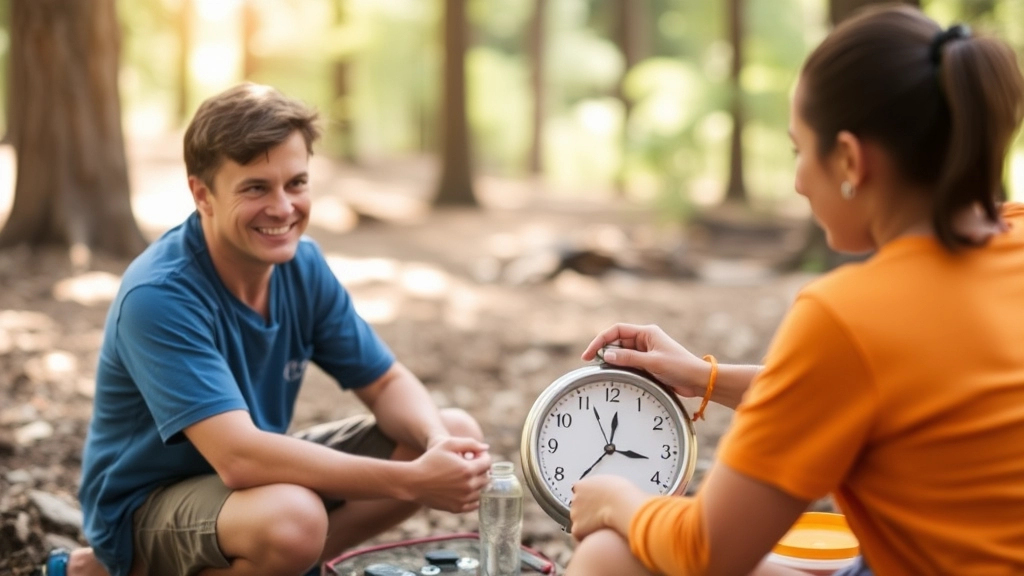
Ever feel like you’re constantly racing against the clock at camp?
Yeah, me too.
Managing time effectively during camp activities is a real game-changer.
Let’s dive in and make sure you’re not just surviving camp, but thriving.
Why Time Management is Crucial
First off, why should you care?
Simple.
Without good time management, chaos reigns.
Kids get bored.
Activities run over.
And you end up frazzled.
Start with Clear Goals
What do you want to achieve with each activity?
Be specific.
- Skill-building: Maybe you’re teaching archery.
- Fun: Maybe it’s a water balloon fight.
- Teamwork: Perhaps a group project.
Know your goals, and you’ll know how to allocate your time.
Break It Down
Big tasks can be overwhelming.
Break them into smaller chunks.
- Setup: Get everything ready.
- Instruction: Explain the rules or skills.
- Activity Time: Let the kids loose.
- Wrap-Up: Recap and clean up.
Use Timers and Alarms
No one likes to be the bad guy, constantly checking the clock.
Use timers.
Set alarms.
- Short bursts: 10-15 minutes for quick activities.
- Longer sessions: 30-45 minutes for more involved tasks.
Timers keep everyone on track without you having to nag.
Flexibility is Key
Let’s be real.
Not everything goes as planned.
Have a backup plan.
- Rainy day? Have indoor activities ready.
- Activity flops? Switch it up.
Being flexible keeps the day smooth and stress-free.
Involve the Kids
Kids love to know what’s coming next.
It keeps them engaged.
- Visual schedules: Use charts or boards.
- Countdowns: Give them a heads-up when time’s almost up.
Real-Life Example
Last summer, we had a crafting session that was supposed to last an hour.
But guess what?
The kids finished in 30 minutes.
We had a backup plan: an impromptu dance party.
It saved the day and kept the energy high.
Balance Structured Time and Free Time
Kids need both.
- Structured time: Activities with clear goals.
- Free time: Let them explore and unwind.
Too much structure can be stifling.
Too much free time can lead to boredom.
Keep Evaluating
Don’t just set it and forget it.
Evaluate.
- What worked?
- What didn’t?
- What can be improved?
Adjust your schedule as you go.
Incorporating Rest Periods and Free Time into Your Camp Schedule
Ever wondered why your campers seem to crash mid-week? Or why the energy levels plummet right when you need them the most? The answer is simple: rest periods and free time are just as crucial as the activities themselves.
When you’re crafting that perfect summer camp schedule, you can’t just cram it full of back-to-back activities. Kids need downtime. Trust me, I’ve seen it all. If you don’t give them a breather, you’ll end up with a bunch of exhausted, cranky campers. And nobody wants that, right?
Why Rest Periods Matter
Rest isn’t just about giving kids a break. It’s about letting their bodies and minds recharge. Here’s why you need to slot in those rest periods:
- Physical Recuperation: Activities can be physically demanding. Rest periods help kids recover and prevent injuries.
- Mental Reset: Constant stimulation can overwhelm young minds. Free time allows them to process and absorb what they’ve learned.
- Social Interaction: Unstructured time lets kids socialise naturally, fostering friendships and teamwork.
How to Slot in Free Time
So, how do you do it? How do you carve out that precious downtime without sacrificing the fun stuff? Here’s a simple approach:
- Morning Breaks: After the first activity, include a 15-20 minute break. This helps kids acclimate to the day’s pace.
- Lunch Hour: Make sure lunch isn’t rushed. A full hour gives them time to eat and unwind.
- Afternoon Downtime: Post-lunch, include a 30-45 minute rest period. Trust me, it works wonders.
- End-of-Day Chill: Before heading home, give them a 20-minute wind-down period. It helps transition from camp activities to home life.
Example Schedule with Rest Periods
| Time | Activity | Duration |
|---|---|---|
| 9:00 – 9:15 | Welcome & Warm-Up | 15 mins |
| 9:15 – 10:15 | First Activity | 1 hour |
| 10:15 – 10:35 | Morning Break | 20 mins |
| 10:35 – 11:35 | Second Activity | 1 hour |
| 11:35 – 12:00 | Free Time | 25 mins |
| 12:00 – 1:00 | Lunch | 1 hour |
| 1:00 – 1:45 | Rest Period | 45 mins |
| 1:45 – 2:45 | Third Activity | 1 hour |
| 2:45 – 3:00 | Afternoon Snack | 15 mins |
| 3:00 – 4:00 | Fourth Activity | 1 hour |
| 4:00 – 4:20 | End-of-Day Chill | 20 mins |
Real Stories, Real Results
I remember one summer, we had a group of energetic 8-year-olds. Day one, they were bouncing off the walls. By day three, they were dragging their feet. We tweaked the schedule, adding in more rest periods and free time. The difference was night and day. They were happier, more engaged, and ready to take on each activity with renewed energy.
Balancing Act: Fun and Rest
Balancing fun and rest isn’t just a nice-to-have; it’s essential. Here’s how to keep it fresh and engaging:
- Mix It Up: Alternate between high-energy and low-energy activities.
- Listen to the Kids: Sometimes, they’ll tell you (directly or indirectly) when they need a break.
- Flexibility is Key: Be ready to adjust the schedule based on the group’s energy levels and feedback.
For more ideas on creating engaging camp experiences, check out our Creative Summer Camp Name Ideas and explore the Top Summer Camp Chants to energize your campers.
How to Handle Unforeseen Changes in Your Camp Schedule
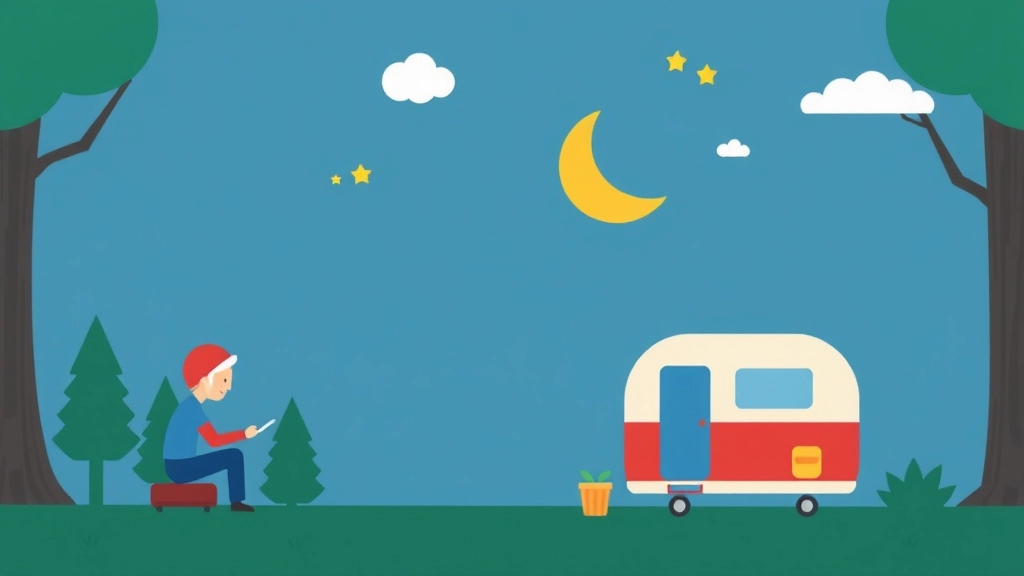
Alright, let’s get real. Unforeseen changes in your camp schedule can be a nightmare. But hey, it happens to the best of us.
What if it rains?
What if a key staff member falls sick?
What if the bus breaks down?
These are the worries keeping you up at night.
But don’t sweat it. Here’s how we roll with the punches.
Stay Flexible and Adaptable
First off, flexibility is your best friend. A rigid schedule is like a house of cards; one gust of wind, and it’s down. So, build in some wiggle room.
- Buffer Time: Add 10-15 minutes between activities.
- Plan B: Always have a backup activity ready.
- Indoor Options: Keep some indoor games or crafts handy for rainy days.
Communicate Quickly and Clearly
When changes hit, communication is key. You’ve got to keep everyone in the loop.
- Staff Briefing: Huddle up with your team first.
- Parent Updates: Use SMS or a camp app to notify parents.
- Camper Announcements: Gather the kids and explain the new plan.
Delegate and Divide Tasks
You can’t do it all. Delegate tasks to your team to manage the chaos efficiently.
- Task List: Break down what needs to be done.
- Assign Roles: Who’s handling what? Make it clear.
- Check-in Points: Regularly touch base to ensure everything’s on track.
Keep the Energy Up
Changes can throw off the vibe. Keep the energy high to maintain morale.
- Games and Icebreakers: Quick games can reset the mood.
- Music: Play some upbeat tunes to lift spirits.
- Positive Attitude: Your attitude sets the tone. Stay upbeat.
Real-Life Example
Last summer, we had a sudden thunderstorm. Our outdoor adventure day was a wash. But we had a Plan B: indoor scavenger hunt. We split the kids into teams, and they were running around, laughing and having a blast. Parents were updated via the camp app, and staff knew exactly what to do. Crisis averted, fun maintained.
Review and Learn
After the dust settles, review what happened. What worked? What didn’t?
- Team Debrief: Sit down with your team and discuss.
- Parent Feedback: Send out a quick survey.
- Adjust Future Plans: Use what you learned to tweak future schedules.
Handling unforeseen changes doesn’t have to be a disaster.
Stay flexible, communicate clearly, delegate tasks, keep the energy up, and always learn from the experience.
Keep it real, keep it fresh, and keep it engaging.
You’ve got this.
Essential Tools for Creating and Editing Camp Schedules
Alright, let’s get down to it. If you’re running a summer camp, you know that creating and editing schedules can be a real pain. But hey, it doesn’t have to be. With the right tools, you can streamline the whole process and make sure your camp runs smoother than a freshly waxed surfboard.
What Tools Do You Need?
First off, you need tools that are easy to use, versatile, and reliable. No one wants to spend hours figuring out complicated software. Here’s a rundown of some essential tools that’ll make your life easier:
Google Sheets
- Why It Rocks: It’s free, collaborative, and super easy to use.
- How to Use It: Create a basic template and share it with your team. Everyone can update it in real-time, so you’re always on the same page.
- Pro Tip: Use conditional formatting to highlight important activities or deadlines.
Microsoft Excel
- Why It Rocks: Powerful and packed with features for advanced scheduling.
- How to Use It: Set up a master schedule with different tabs for daily, weekly, and special events.
- Pro Tip: Use pivot tables to get an overview of resource allocation and activity distribution.
Trello
- Why It Rocks: Visual, intuitive, and perfect for team collaboration.
- How to Use It: Create boards for different aspects of your camp schedule â daily activities, weekly themes, special events.
- Pro Tip: Use labels and due dates to keep everything organised and on track.
Canva
- Why It Rocks: Ideal for creating visually appealing schedules.
- How to Use It: Use pre-made templates or design your own. Great for printing and sharing with campers and parents.
- Pro Tip: Incorporate your camp’s branding to make it look professional and engaging.
Camp Management Software (e.g., CampMinder, Active Network)
- Why It Rocks: All-in-one solutions designed specifically for camps.
- How to Use It: These platforms often come with built-in scheduling tools, communication features, and more.
- Pro Tip: Take advantage of their customer support to get the most out of the software.
Why These Tools Matter
Let’s be real. The last thing you want is a chaotic camp where no one knows what’s happening next. These tools help you avoid that by:
- Ensuring Consistency: Everyone follows the same schedule, reducing confusion.
- Saving Time: Automate repetitive tasks and focus on what really matters â making the camp fun and educational.
- Improving Communication: Keep staff, campers, and parents in the loop with real-time updates.
- Flexibility: Easily adapt to changes without having to start from scratch.
Real-World Example
Imagine you’re running an adventure camp. One day, a sudden storm forces you to cancel outdoor activities. With Google Sheets, you can quickly update the schedule and notify everyone. Or, if you’re using Trello, you can drag and drop activities to rearrange the day. Simple, right?
For more tips on making your summer camp a hit, check out our ultimate packing guide and explore the top summer camp greeting card designs and ideas to keep the excitement going!
Integrating Parent Communication in Your Camp Schedule

How do you keep parents in the loop without losing your mind?
It’s a real concern.
Parents want to know what’s happening at camp, and you want to make sure they feel connected.
Here’s how we do it.
Why Parent Communication Matters
Parents are your partners.
They need to know their kids are safe and having fun.
Keeping them informed builds trust and makes your camp run smoother.
Key Strategies for Effective Communication
1. Daily Updates:
- Send brief emails or texts.
- Highlight key activities and any changes.
2. Weekly Newsletters:
- Share a recap of the week.
- Include photos and stories of what the kids did.
3. Open Channels:
- Use apps or platforms for real-time updates.
- Encourage parents to ask questions.
Tools to Make It Easy
Use Technology:
- Platforms like Remind or ClassDojo can streamline communication.
- Consider setting up a WhatsApp group for quick updates.
Create a Communication Plan:
- Decide how often you’ll update parents.
- Stick to a schedule so parents know when to expect news.
Real-Life Example
Last summer, we had a parent who was anxious about their child’s first camp experience.
We sent daily photos and a quick note about how the child was doing.
By the end of the week, the parent was relaxed and grateful.
Handling Challenges
Sometimes, things don’t go as planned.
Here’s what to do:
- Be honest if there’s a change in schedule.
- Communicate promptly and clearly.
- Offer solutions if needed.
Best Practices for Monitoring and Updating Your Camp Schedule
Worried about keeping your summer camp schedule on track?
You’re not alone.
Let’s dive into some best practices for monitoring and updating your camp schedule.
Why is this so important?
Because a well-monitored schedule means a smoother camp experience for everyone. Discover how unique experiences can enhance your camp’s schedule.
1. Regular Check-ins
Set up daily or weekly check-ins to review the schedule.
This helps to catch any issues before they become big problems.
2. Flexibility is Key
Keep your schedule flexible.
Things change.
Weather, camper moods, or even a surprise visit from a guest speaker.
Be ready to pivot.
3. Use Tech to Your Advantage
There are loads of tools out there to help you monitor and update your schedule.
Google Calendar, Trello, or even a good old-fashioned spreadsheet.
4. Get Feedback
Talk to your staff and campers.
What’s working?
What’s not?
Use this feedback to tweak your schedule.
5. Stay in the Loop
Keep an eye on the bigger picture.
Are you meeting your camp goals?
Is everyone having fun?
Learning new things? Check out our tips on top activities and choices for inspiration.
6. Communicate Changes
If you need to make changes, let everyone know ASAP.
Parents, staff, and campers should all be in the loop.
7. Document Everything
Keep a log of what changes were made and why.
This helps with planning future camps and avoiding past mistakes.
8. Be Proactive
Don’t wait for problems to pop up.
Anticipate them.
Have a Plan B (and maybe even a Plan C).
Real Talk
Last summer, we had a sudden thunderstorm.
Our outdoor activities were a no-go.
Thanks to our flexible schedule, we quickly switched to indoor games and crafts.
No one missed a beat.
FAQs: Summer Camp Schedule Template
What are the key elements to include in a summer camp schedule?
When creating a summer camp schedule, ensure it includes activity variety, structured time vs. free time, meal and snack breaks, transition periods, special events, safety and emergency procedures, and rest periods.
How can I customize a summer camp schedule for different age groups?
Customizing involves understanding the different needs of each age group. Younger kids need frequent breaks and simple activities, tweens require structured learning and some independence, while teens crave challenging tasks and flexibility.
Why should I use printable summer camp schedule templates?
Printable templates save time, ensure consistency, and present a professional appearance. They also make it easy to tweak and adapt the schedule as needed.
Where can I find printable summer camp schedule templates?
You can find a variety of templates by searching for “Printable Summer Camp Schedule Templates” online. Many are available for free, while some may require a small fee.
How do I manage time effectively during camp activities?
Effective time management involves setting clear goals, breaking tasks into smaller chunks, using timers and alarms, staying flexible, involving the kids, and regularly evaluating and adjusting the schedule.
What should I do when unforeseen changes disrupt the camp schedule?
Stay flexible, communicate quickly and clearly, delegate tasks, keep the energy up, and review what happened to improve future plans. Always have buffer time, Plan B activities, and indoor options ready.
How can I integrate parent communication into the camp schedule?
Keep parents informed with daily updates, weekly newsletters, and open communication channels. Use technology like apps and platforms to streamline communication and ensure parents feel connected and informed.
Why is it important to balance structured time and free time in a camp schedule?
Balancing structured time and free time ensures that kids are engaged without feeling overwhelmed. Structured activities have clear goals, while free time allows kids to explore and unwind, preventing boredom and chaos.
How can I handle challenges in parent communication?
Be honest and prompt when communicating changes or issues. Offer solutions and ensure that parents feel heard and informed. Consistent and clear communication builds trust and smooths out camp operations.
References
-
ParentMap: Summer Camp Schedule Tips and Ideas
-
American Camp Association: Creating a Summer Camp Schedule
-
Summer Camp Hub: Summer Camp Schedule Templates

